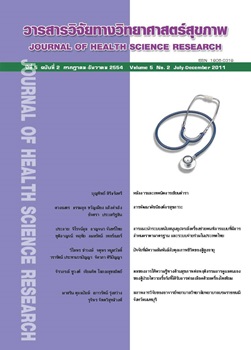การพัฒนาดัชนีองค์กรสุขภาวะ
Main Article Content
บทคัดย่อ
บทคัดย่อ
งานวิจัยนี้มุ่งพัฒนาดัชนีองค์กรสุขภาวะ ใช้วิธีวิจัยแบบผสมผสาน (mixed methods research) เก็บรวบรวมข้อมูล โดย (1) การทบทวนเอกสารและงานวิจัย (2) การสังเคราะห์ดัชนีองค์กรสุขภาวะ (3) การพิจารณาโดยผู้ทรงคุณวุฒิ (4) การทดลองใช้ และ (5) การวิเคราะห์และปรับปรุง คัดเลือกองค์กรกลุ่มตัวอย่างเชิงปริมาณ โดยสุ่มเลือกองค์กรที่มีการประเมินภายนอกเมื่อปี 2551 จำนวน 93 องค์กร และองค์กรกลุ่มตัวอย่างเชิงคุณภาพ คัดเลือกโดยกำหนดเกณฑ์การคัดเลือก จำนวน 8 องค์กร ผู้ให้ข้อมูล ได้แก่ ผู้บริหาร กลุ่มบริหารงานบุคคล นักบริหารทรัพยากรมนุษย์ เครื่องมือที่ใช้ในการเก็บรวบรวมข้อมูลเชิงปริมาณ ได้แก่ คู่มือประเมินตนเองตามดัชนีองค์กรสุขภาวะ และแบบสอบถามพนักงานสำหรับข้อมูลเชิงคุณภาพ ได้แก่ แนวทางการสัมภาษณ์ การวิเคราะห์ข้อมูลเชิงคุณภาพใช้การวิเคราะห์เนื้อหา และการวิเคราะห์ข้อมูลเชิงปริมาณใช้การวิเคราะห์ค่าความถี่ ค่าร้อยละ และการวิเคราะห์องค์ประกอบเชิงสำรวจ (exploratoryfactor analysis: EFA)
ผลการวิจัย พบว่า ได้ชุดดัชนีจำนวน 39 ดัชนีย่อย 5 มิติ คือ มิติที่ 1 การบริหารทรัพยากรมนุษย์ (6 ดัชนีย่อย)มิติที่ 2 สภาพแวดล้อมและบรรยากาศการสร้างเสริมสุขภาวะ (10 ดัชนีย่อย) มิติที่ 3 กระบวนการดำเนินงานสร้างเสริมสุขภาวะในองค์กร (8 ดัชนีย่อย) มิติที่ 4 สุขภาพกายและสุขภาพใจ (11 ดัชนีย่อย) และมิติที่ 5 ผลลัพธ์ (4 ดัชนีย่อย) ผลการวิเคราะห์องค์ประกอบเชิงสำรวจ นำมาสร้างองค์ประกอบที่สำคัญได้ 4 องค์ประกอบ คือ องค์ประกอบที่ 1บรรยากาศการทำงาน (18 ดัชนีย่อย) มีค่าน้ำหนักองค์ประกอบระหว่าง 0.39 - 0.86 องค์ประกอบที่ 2 การบริหารทรัพยากรมนุษย์ (9 ดัชนีย่อย) มีค่าน้ำหนักองค์ประกอบระหว่าง 0.48 - 0.67 องค์ประกอบที่ 3 สุขภาพกายและสุขภาพใจ (6 ดัชนีย่อย) มีค่าน้ำหนักองค์ประกอบระหว่าง 0.50 - 0.81 องค์ประกอบที่ 4 การเติบโตหรือคุณภาพผลผลิตขององค์กร (6 ดัชนีย่อย) มีค่าน้ำหนักองค์ประกอบระหว่าง 0.35 - 0.77 ซึ่งสามารถอธิบายความแปรปรวนในดัชนีทั้ง 39ดัชนีย่อยได้ในระดับดี (ร้อยละ 56.92) การวิจัยครั้งต่อไป ควรมีการกำหนดเกณฑ์ในการวัดระดับสุขภาวะองค์กรเพื่อองค์กรจะได้ใช้เป็นแนวทางในการวัดผลลัพท์ของกิจกรรมสร้างเสริมสุขภาพองค์กรต่อไป
Abstract
This research aimed to study and develop Healthy Organization Index using mixed methodsresearch. The data were collected using various methods such as: (1) review literature, (2) synthesis ofhealthy organization index, (3) checking content validity by experts, (4) pilot study, and (5) analysis andimprovement. Selection of 93 organizations for quantitative sampling was done by randomly selectingorganizations subjected to external review in 2008. Selection of 8 organizations for qualitative samplingwas done by assignment of selection criteria of informants including the organization leader, the staff in personnel administration and human resourcesmanagement divisions. The research toolsconsisted of the self-evaluation handbook forhealthy organization, questionnaires for asking thestaff and guideline for interviews. Qualitative datawere analysed using content analysis andquantitative data were analysed using frequency,percentages, and exploratory factor analysis (EFA) The result revealed that the developedHealthy Organization Index was comprised 39indices set with 5 dimensions. The first dimensionwas human resources management (6 subindices),the second dimension was environmentand atmosphere in enhancing health (10 subindices),the third dimension was healthyorganization creation process (8 sub-indices), thefourth dimension was physical and mental health(11 sub-indices), and the fifth dimension wasresults (4 sub-indices). Results of EFA created 4crucial components which are: component 1-Working atmosphere (18 sub-indices) with factorloading between 0.39 - 0.86, component 2-Humanresources management (9 sub-indices) with factorloading between 0.48 - 0.67, component 3-Physicaland mental health (4 sub-indices) with factorloading between 0.50 - 0.81, and component 4-Growth or organizational products quality (4 subindices)with factor loading between 0.35 - 0.77,which adequately explained variability in the 39indices and its sub-indices (56.92%). Thus, theorganization can used be the criteria as guidelinesfor evaluating outcomes of healthy organizationpromotion activities.
Downloads
Article Details
บทความที่ได้รับการตีพิมพ์เป็นลิขสิทธิ์ของวิทยาลัยพยาบาลบรมราชชนนี จังหวัดนนทบุรี
ข้อความที่ปรากฏในบทความแต่ละเรื่องในวารสารวิชาการเล่มนี้เป็นความคิดเห็นส่วนตัวของผู้เขียนแต่ละท่านไม่เกี่ยวข้องกับวิทยาลัยพยาบาลบรมราชชนนี จังหวัดนนทบุรี และคณาจารย์ท่านอื่น ในวิทยาลัยฯ แต่อย่างใด ความรับผิดชอบองค์ประกอบทั้งหมดของบทความแต่ละเรื่องเป็นของผู้เขียนแต่ละท่าน หากมีความผิดพลาดใด ๆ ผู้เขียนแต่ละท่านจะรับผิดชอบบทความของตนเองแต่ผู้เดียว


